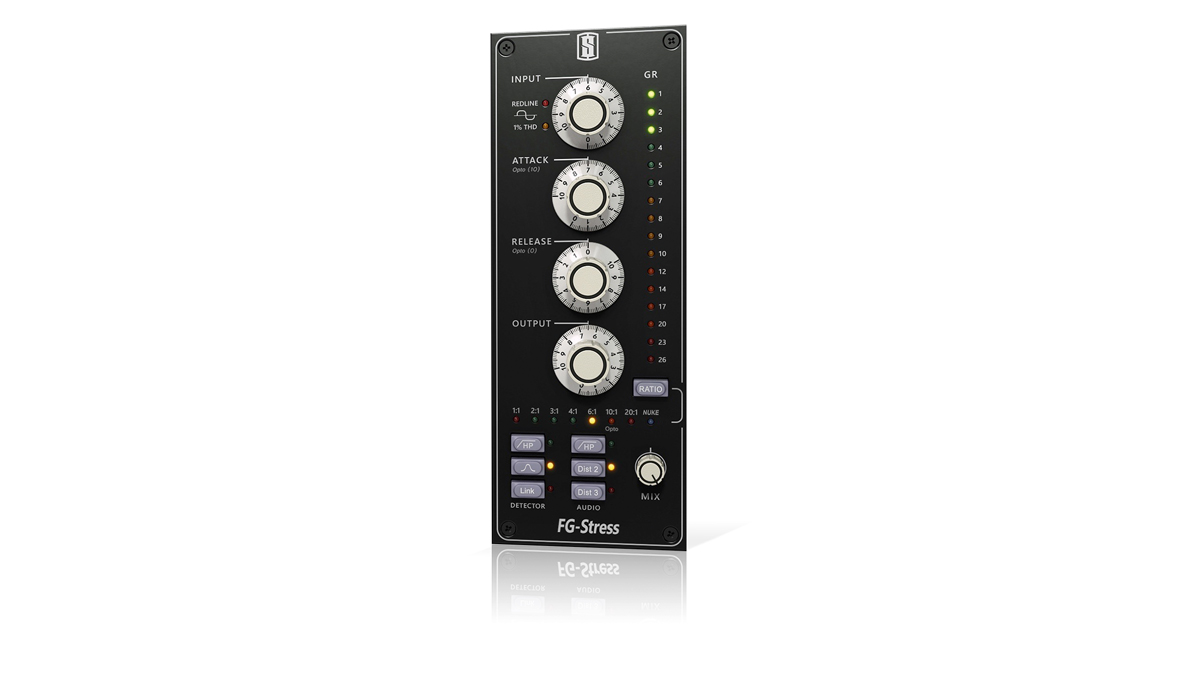MusicRadar Verdict
So close to the real thing that you won’t be able to tell the difference, FG-Stress is Slate’s best VMR module yet.
Pros
- +
The closest software emulation of the Distressor yet.
- +
Amazing versatility and range.
- +
Dry/wet mix control.
Cons
- -
Virtual Mix Rack feels like overkill when running a single module.
MusicRadar's got your back
Described as “the most challenging development in [its] history”, FG-Stress is Slate Digital’s take on the Empirical Labs Distressor, Dave Derr’s revered mid-90s dynamics processor.
“It was equal to developing eight different compressor plugins with their own characteristics,” say Slate, referring to the Distressor’s chameleon-like ability to sound and behave very differently depending on which of its eight Ratios is selected.
Racked up
A module for Slate’s excellent Virtual Mix Rack ‘shell’ plugin (VST/AU/AAX) rather than a plugin in its own right, FG-Stress can be had for the one-off price above, or as part of their hugely attractive Everything Bundle subscription ($15pcm or $180pa).
Unlike Empirical Labs’ own Distressor emulation, Arousor, which added various new features to the original design, FG-Stress is a near-1:1 copy of it - albeit in stereo rather than mono, minus the 1176N-style all- buttons-in ‘British mode’, and a Mix knob for parallel compression.
The whole thing has been comfortably packed down into VMR’s lunchbox format, where it looks even more approachable and straightforward than its admirably intuitive hardware counterpart.
With the compression ratio setting (see A certain Ratio) established by clicking the Ratio button or a specific Ratio LED, driving the compression circuit and shaping its response curve are done with the four main knobs.
The Distressor’s exceptionally versatile list of Ratio settings, each with their own threshold and knee shapes, are central to its sound and ‘action’. Even 1:1 has an audible effect, introducing beautifully warming distortion; while at the other end of the scale, the famous Nuke setting applies energetic brick wall limiting with a logarithmic release. In between those two extremes, the 2:1, 3:1, 4:1 and 6:1 Ratios work to an increasingly steep knee, with 6:1 proving the most ‘general purpose’ of the lot, and 2:1’s exceptionally long knee making it ideal for gentle treatments. The 20:1 Ratio is similar to Nuke but with a different knee and linear release.
Finally, 10:1 switches to an entirely different circuit, for Opto-style compression. Shift+Clicking the 10:1 button sets the Attack and Release to 10 and 0 respectively - the recommended settings on the Distressor for emulating classic opto-VCA compressors of old, such as the LA-2A and LA-3A.
Raising the Input level overdrives the compressor, and two flavours of distortion are on hand via the Dist 2 and Dist 3 buttons, introducing 2nd or 3rd harmonics for smooth valve- or crunchy tape-style distortion. The adjacent HP button activates an 18dB/octave high-pass filter on the output, rolling off everything below 80Hz for low-end control.
The sidechain signal is stereo by default (with a stereo source, obviously), but activating the Link Detector mode sums left and right to mono, for equal gain reduction on both sides. The other two Detector buttons tailor the sidechain with a high-pass filter (86Hz) to reduce low-frequency triggering, and a bell-shaped boost at 6kHz for catching high-mid peaks such as harshness in vocals and cymbals.
The Attack and Release time ranges match those of the Distressor, too, of course. The former can sit anywhere between 0.05ms and 30ms, while Release stretches from 50ms to 3.5s, extending to an extremely languid 20s in 10:1 Opto mode.
Stress relief
Near-as-dammit identical to the real thing, FG-Stress is the most sonically authentic Distressor emulation yet. It might not have the extra bells and whistles of Arousor, but it costs almost half as much while still capturing the sound and feel of Empirical’s magical box perfectly.
The very epitome of a ‘Swiss army knife’ compressor, it’s equally at home bringing power and punch to drums or flattening and fattening basslines as it is focusing vocals and gluing mix busses of all kinds.
We can’t fault it, except to say that, like all Virtual Mix Rack modules, we wish we could load it as a regular plugin on its own, rather than having to run the VMR shell whether we want to or not.
Computer Music magazine is the world’s best selling publication dedicated solely to making great music with your Mac or PC computer. Each issue it brings its lucky readers the best in cutting-edge tutorials, need-to-know, expert software reviews and even all the tools you actually need to make great music today, courtesy of our legendary CM Plugin Suite.
"I said, “What’s that?” and they said, “It’s what Quincy Jones and Bruce Swedien use on all the Michael Jackson records": Steve Levine reminisces on 50 years in the industry and where it’s heading next
“Excels at unique modulated timbres, atonal drones and microtonal sequences that reinvent themselves each time you dare to touch the synth”: Soma Laboratories Lyra-4 review
“I used everything I knew about music”: How Green Day exceeded expectations with their most ambitious song











